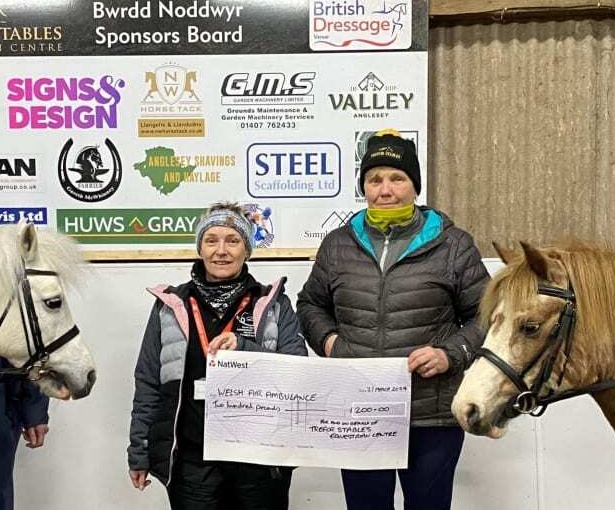In December 2021, our service became a 24-hour operation, with nighttime operations being introduced at our Cardiff base from 7pm to 7am.
It had always been our vision to provide a 24/7 operation to the people of Wales, and in December 2021 we achieved that goal, launching a 24/7 service from our Cardiff base – all thanks to your generous donations.
Previously, the service had operated for 12 hours per day, between 8am and 8pm. This meant that we would be unable to attend patients who needed critical care after 8pm.
The need for an overnight service was identified following detailed research into life or limb-threatening emergencies that took place outside the services’ operational hours of 7am to 8pm. Over a 12-month period, there were approximately 990 cases of ‘unmet need’ with demand most prevalent in South-East Wales.
Now, as a 24/7 service, we can reach more patients every year.

Help to keep us flying at night!
Night Flying Facts
Flying at night provides its own challenges and coordination, take a look at some facts for flying at night.

After 7pm

15 minutes

Google Earth

Risks

Landing area

Search Lights

Night Vision

White light

After 7pm

15 minutes

Google Earth

Risks

Landing area

Search Lights

Night Vision

White light

After 7pm

15 minutes

Google Earth

Risks

Landing area

Search Lights

Night Vision

White light
Flying at Night – A Pilot’s Perspective
We asked our Head of Flight Operations, James Grenfell, what it is like flying in the hours of darkness.
“For HEMS (Helicopter Emergency Medical Services), there’s a substantial difference between day and night operations. Lack of visibility and difficulty in identifying wires and obstacles are one of many hazards we face at night.
For daylight missions, once the patient location has been identified, we select a landing site whilst overhead and conducting a recce. However, at night this task becomes much more difficult, therefore we spend more time prior to take-off identifying primary and secondary landing site. A secondary landing site is chosen in case landing at our primary site is not possible.
Wales Air Ambulance operates a multi-pilot night operation where there are many procedures and rules in place mitigating many challenges, and ensuring we keep everyone safe.
In addition to being a qualified HEMS pilot, 24-hour operations require the use of NVG (Night Vision Goggles) and a multi pilot qualification. We are subjected to hours of NVG training, currency, and annual checks to ensure that we meet and maintain the required experience levels and qualifications.
Our single pilot bases also fly at night, however landing at a HEMS scene is always conducted within our multi pilot role. For night landings to take place safely, our pilots look for landing sites around 30 meters by 60 meters.

The Night Vision Goggles are an amazing (and very expensive) tool that we utilise to enable us to land at the scene during the hours of darkness.
Despite what’s shown in the movies, it doesn’t turn night into day, but it does give a greater enhancement to what we can see. Effectively the NVG enhances any existing light and amplifies it, giving the pilots a better awareness of their surroundings.
They still have limitations and during very dark nights, with little ambient lighting in rural areas, workload increases significantly.
Along with NVG, we utilise other systems on board the aircraft such as terrain awareness systems, flight management systems and mapping software. For example, trying to identify wires on NVG is almost impossible, but by utilising all the aircraft systems, along with the training and experience our pilots have, ensures we conduct each mission in the safest possible way and get the Wales Air Ambulance medics to the sickest patients, wherever they are in Wales.”


David's story
Pembrokeshire dad is one of many patients to have benefitted from a 24/7 service
Pembrokeshire dad-of-three David Davies was getting ready for bed when he collapsed and had a cardiac arrest. His wife Taryan and son Caleb, then 18, performed CPR on David while waiting for an ambulance to arrive.
Read more
When the paramedics arrived, David’s heart was in an abnormal rhythm and not beating normally. The paramedics took over resuscitation, delivered two shocks and the second shock brought his heart back into a normal rhythm.
When the Wales Air Ambulance Charity helicopter arrived with its overnight critical care team David started to come around and became agitated and wasn’t breathing effectively. They rapidly assessed him and found his oxygen levels were low and needed to take over his breathing.
They gave him a general anaesthetic and then placed him on a ventilator to breathe for him, a complex and time-critical procedure and only possible outside of a hospital environment through the Wales Air Ambulance. It is one of many emergency department-standard treatments that the Charity is now able to deliver at the scene of an incident – improving the chances of survival and recovery.
The learning support assistant, at Haverfordwest High School, underwent surgery to have three stents put in and was discharged from hospital a few days later.
David said: “I am forever grateful to the ambulance service and the Wales Air Ambulance for the work they did and to get me to the hospital as quickly as they did. I really appreciate everything they’ve done for me. If it wasn’t for them, I wouldn’t be here.”
Dai’s story highlights the importance of having an air ambulance service that runs during the night as well as the day.
Jo Yeoman is a patient liaison nurse who works in partnership with the Wales Air Ambulance Charity. She said: “David’s story demonstrates the vital chain of survival, from CPR, defibrillation and then critical care. Taryan and Caleb were incredible and the partnership work between the Wales Air Ambulance and Welsh Ambulance Service medics ensured that David had the best possible care before reaching the specialists at Morriston Hospital.”


